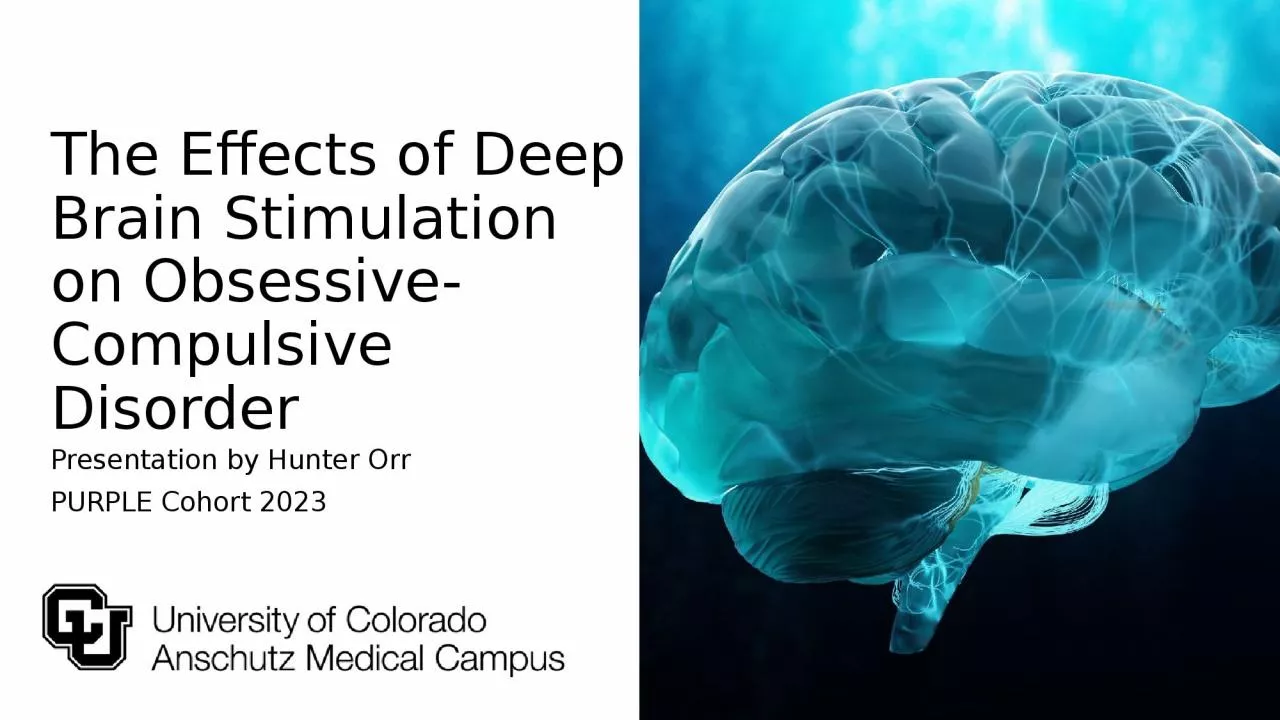

Presentation by Hunter Orr PURPLE Cohort 2023 ObsessiveCompulsive Disorder An Overview Obsessions The egodystonic intrusive thoughts causes distress Mental disorder that effects ID: 1045365
Download Presentation The PPT/PDF document "The Effects of Deep Brain Stimulation on..." is the property of its rightful owner. Permission is granted to download and print the materials on this web site for personal, non-commercial use only, and to display it on your personal computer provided you do not modify the materials and that you retain all copyright notices contained in the materials. By downloading content from our website, you accept the terms of this agreement.
1. The Effects of Deep Brain Stimulation on Obsessive-Compulsive DisorderPresentation by Hunter OrrPURPLE Cohort 2023
2. Obsessive-Compulsive Disorder: An OverviewObsessions – The ego-dystonic “intrusive thoughts”, causes distressMental disorder that effects 2 – 3% of the United States, 1 – 2% of the worldCompulsions – The actions/habits that people will perform to alleviate the distress of the obsessionsComorbidities include depression, anxiety, eating disorders, tic disordersEven with optimal treatment, including therapy (CBT, ERP) and medications, only 35% of patients reach “remission”
3. Deep Brain StimulationInvasive procedure designed in 1987 for essential tremor, used for other illnesses since such as Parkinson’sElectric stimulation of the ventral internal capsule/ventral striatum (motivated behavior)Granted Humanitarian Device Exemption for OCD in 2009Pulse GeneratorExtension WireLeadElectrodesExample of lead with four electrode positionsMultiple positions allows for a large range of settingsProgramming after surgery looks for ideal settingsAmplitude (V)Pulse width (T)FrequencyElectrode configuration1432
4. YBOCS score ≥ 2820+ sessions of ERPAt least 3 trials of SSRIs, one of which being ClomipramineAt least one month using benzodiazepinesAt least one month using an anti-psychoticAny previous or current psychotic disordersPrevious or current bipolar disordersActive substance abuseActive eating disordersActive and intentional suicidalityCriteria for DBS Participation
5. CU Anschutz Medical Campus has nine current patients undergoing DBS programming for their obsessive-compulsive symptoms.Data has been kept for each patient over their time in the program.Scores are taken for multiple scales related to OCD and its comorbidities, including...YBOCS (OCD)MADRS (Depression)HAM-A (Anxiety)YMRS (Mania)Q-LES-Q-SF (Quality of Life)
6. Before analysis, it was predicted that each patient would improve in their scores on each of the five scales over time.This study analyzed the collected data, testing for possible significant trends in the scores of patients.
7. MethodsParticipantsEight adultsParticipation ranges from 2-7 yearsOne patient taken out of data analysis due to insufficient duration of programming6 men, 2 womenData CollectionFive rater-administered scales given to patients before their programming sessions.Patients also underwent CBT and ERP therapies while continuing with programmingData was taken from the following points in time:Before surgeryBefore programmingOne monthThree monthsSix monthsOne yearTwo yearsData AnalysisOne-way ANOVA was used to measure significant effects between scores and point in time.Time = IndependentScore = DependentPairwise T-test was used to check for significant differences between each point in time
8. No post-hoc test requiredHAM-A
9. No post-hoc test requiredQ-LES-Q-SF
10. No post-hoc test requiredYMRS
11. MADRS
12. YBOCS
13. DiscussionThe only scales that upheld the prediction going into the studyYBOCS directly measure OCDDepression is a prevalent comorbidity with OCDP-values indicate a trend towards significanceNotable stagnation in social quality of life on scales, could be holding the effect in checkThis could also be seen in possible remaining social anxietyYMRS analysis nearly shows instances of increased mania symptomsCould possibly provide quantitative proof as to why bipolar disorder remains an exclusion factor for DBS treatmentYBOCS/MADRS see significant effectsQ-LES-Q-SF/HAM-A come up as insignificant YMRS shows least effects at p = 0.372
14. ImplicationsThe Federal Parity Act (2008) was passed in order to equalize access to clinical care for mental illness with that of physical illness Insurance companies continuously deny claims related to DBS for OCD, claiming it to be “investigational and not medically necessary”Lack of available sample size doesn’t allow DBS to shed its HDE statusHDE status continues to bother insurance companiesThis study suggests:DBS is especially effective in targeting OCDComorbidities follow suit, which makes sensePossible quality of life improvementFar more research is required → insurance policies need to change to allow greater sample size
15. StrengthsStrong uniformity between patients in treatmentLong duration of study – 7 years for some peopleMain-focus in clinically treating patients – research comes as a bonusWeaknessesLimited sample sizeInconsistent time intervals between patient’s visits – points in time aren’t the same for everyoneFuture DirectionsFurther (and ongoing) exploration into quality-of-life trends among DBS patientsAltruism within OCD patientsFurther research on DBS and obsessions vs. compulsions, types of each
16. https://www.ncbi.nlm.nih.gov/pmc/articles/PMC8387630/https://www.ncbi.nlm.nih.gov/pmc/articles/PMC8631971/https://www.hopkinsmedicine.org/health/treatment-tests-and-therapies/deep-brain-stimulationhttps://www.ncbi.nlm.nih.gov/pmc/articles/PMC8044872/https://www.ncbi.nlm.nih.gov/pmc/articles/PMC4093791/ReferencesSpecial thanks to Emily Hemendinger, Dr. Rachel Davis, and the entire PURPLE staff for all your help this summer